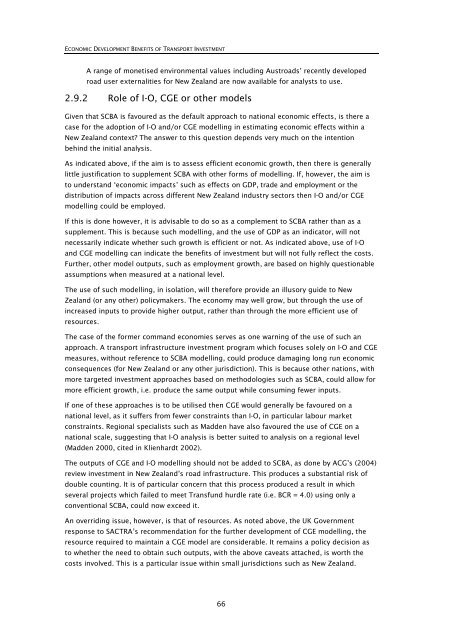Research 350 - NZ Transport Agency
Research 350 - NZ Transport Agency
Research 350 - NZ Transport Agency
You also want an ePaper? Increase the reach of your titles
YUMPU automatically turns print PDFs into web optimized ePapers that Google loves.
ECONOMIC DEVELOPMENT BENEFITS OF TRANSPORT INVESTMENT<br />
A range of monetised environmental values including Austroads’ recently developed<br />
road user externalities for New Zealand are now available for analysts to use.<br />
2.9.2 Role of I-O, CGE or other models<br />
Given that SCBA is favoured as the default approach to national economic effects, is there a<br />
case for the adoption of I-O and/or CGE modelling in estimating economic effects within a<br />
New Zealand context? The answer to this question depends very much on the intention<br />
behind the initial analysis.<br />
As indicated above, if the aim is to assess efficient economic growth, then there is generally<br />
little justification to supplement SCBA with other forms of modelling. If, however, the aim is<br />
to understand ‘economic impacts’ such as effects on GDP, trade and employment or the<br />
distribution of impacts across different New Zealand industry sectors then I-O and/or CGE<br />
modelling could be employed.<br />
If this is done however, it is advisable to do so as a complement to SCBA rather than as a<br />
supplement. This is because such modelling, and the use of GDP as an indicator, will not<br />
necessarily indicate whether such growth is efficient or not. As indicated above, use of I-O<br />
and CGE modelling can indicate the benefits of investment but will not fully reflect the costs.<br />
Further, other model outputs, such as employment growth, are based on highly questionable<br />
assumptions when measured at a national level.<br />
The use of such modelling, in isolation, will therefore provide an illusory guide to New<br />
Zealand (or any other) policymakers. The economy may well grow, but through the use of<br />
increased inputs to provide higher output, rather than through the more efficient use of<br />
resources.<br />
The case of the former command economies serves as one warning of the use of such an<br />
approach. A transport infrastructure investment program which focuses solely on I-O and CGE<br />
measures, without reference to SCBA modelling, could produce damaging long run economic<br />
consequences (for New Zealand or any other jurisdiction). This is because other nations, with<br />
more targeted investment approaches based on methodologies such as SCBA, could allow for<br />
more efficient growth, i.e. produce the same output while consuming fewer inputs.<br />
If one of these approaches is to be utilised then CGE would generally be favoured on a<br />
national level, as it suffers from fewer constraints than I-O, in particular labour market<br />
constraints. Regional specialists such as Madden have also favoured the use of CGE on a<br />
national scale, suggesting that I-O analysis is better suited to analysis on a regional level<br />
(Madden 2000, cited in Klienhardt 2002).<br />
The outputs of CGE and I-O modelling should not be added to SCBA, as done by ACG’s (2004)<br />
review investment in New Zealand’s road infrastructure. This produces a substantial risk of<br />
double counting. It is of particular concern that this process produced a result in which<br />
several projects which failed to meet Transfund hurdle rate (i.e. BCR = 4.0) using only a<br />
conventional SCBA, could now exceed it.<br />
An overriding issue, however, is that of resources. As noted above, the UK Government<br />
response to SACTRA’s recommendation for the further development of CGE modelling, the<br />
resource required to maintain a CGE model are considerable. It remains a policy decision as<br />
to whether the need to obtain such outputs, with the above caveats attached, is worth the<br />
costs involved. This is a particular issue within small jurisdictions such as New Zealand.<br />
66
















